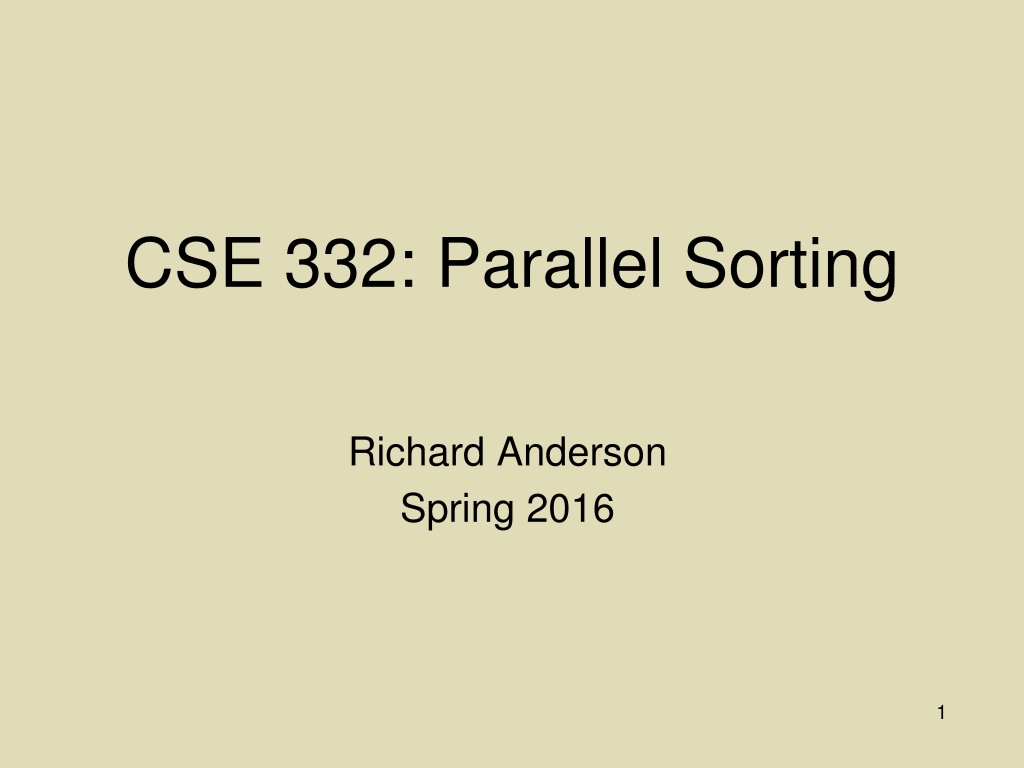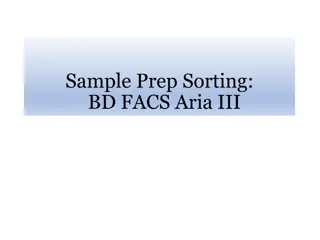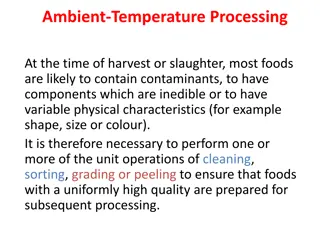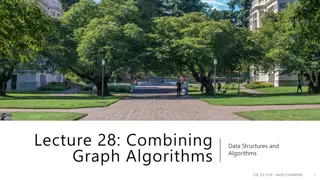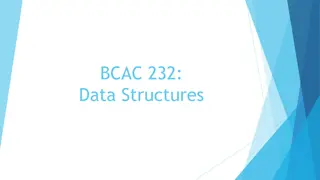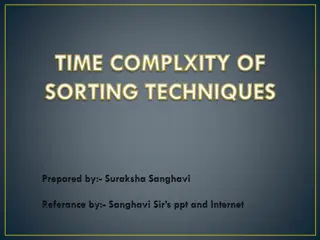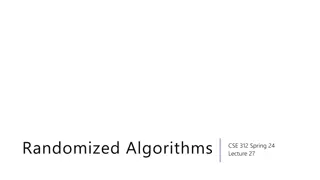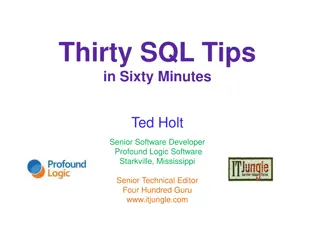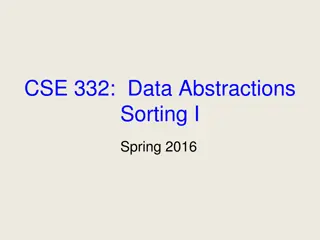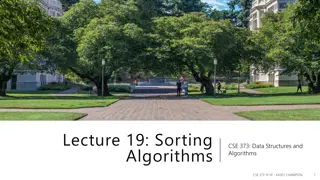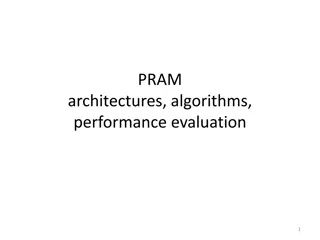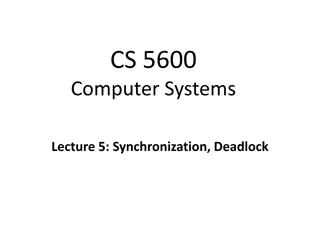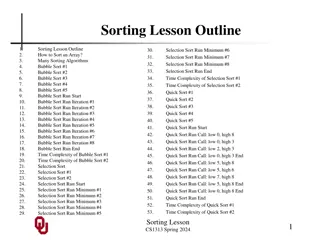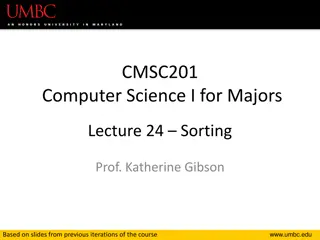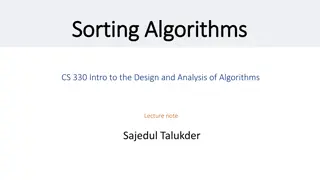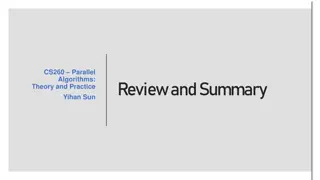Parallel Sorting Algorithms and Amdahl's Law
Exploring the concepts of parallel sorting algorithms, analyzing parallel programs, divide and conquer algorithms, parallel speed-up, estimating running time on multiple processors, and understanding Amdahl's Law in parallel computing. The content covers key measures of run-time, divide and conquer strategies, parallel speed-up calculations, estimating running time, and the impact of parallelization on program performance.
Download Presentation

Please find below an Image/Link to download the presentation.
The content on the website is provided AS IS for your information and personal use only. It may not be sold, licensed, or shared on other websites without obtaining consent from the author.If you encounter any issues during the download, it is possible that the publisher has removed the file from their server.
You are allowed to download the files provided on this website for personal or commercial use, subject to the condition that they are used lawfully. All files are the property of their respective owners.
The content on the website is provided AS IS for your information and personal use only. It may not be sold, licensed, or shared on other websites without obtaining consent from the author.
E N D
Presentation Transcript
CSE 332: Parallel Sorting Richard Anderson Spring 2016 1
Recap Last lectures simple parallel programs common patterns: map, reduce analysis tools (work, span, parallelism) Now Amdahl s Law Parallel quicksort, merge sort useful building blocks: prefix, pack 3
Analyzing Parallel Programs Let TP be the running time on P processors Two key measures of run-time: Work: How long it would take 1 processor = T1 Span: How long it would take infinity processors = T The hypothetical ideal for parallelization This is the longest dependence chain in the computation Example: O(logn) for summing an array Also called critical path length or computational depth 4
Divide and Conquer Algorithms Our fork and join frequently look like this: divide base cases combine results In this context, the span (T ) is: The longest dependence-chain; longest branch in parallel tree Example: O(log n) for summing an array; we halve the data down to our cut-off, then add back together; O(log n) steps, O(1) time for each Also called critical path length or computational depth 5
Parallel Speed-up Speed-up on P processors: T1 / TP If speed-up is P, we call it perfect linear speed-up e.g., doubling P halves running time hard to achieve in practice Parallelism is the maximum possible speed-up: T1 / T if you had infinite processors 6
Estimating Tp How to estimate TP (e.g., P = 4)? Lower bounds on TP(ignoring memory, caching...) 1. T 2. T1 / P which one is the tighter (higher) lower bound? The ForkJoin Java Framework achieves the following expected time asymptotic bound: TP O(T + T1 / P) this bound is optimal 7
Amdahls Law Most programs have 1. parts that parallelize well 2. parts that don t parallelize at all The latter become bottlenecks 8
Amdahls Law Let T1 = 1 unit of time Let S = proportion that can t be parallelized 1 = T1 = S + (1 S) Suppose we get perfect linear speedup on the parallel portion: TP = So the overall speed-up on P processors is (Amdahl s Law): T1 / T P = T1 / T = If 1/3 of your program is parallelizable, max speedup is: 9
Pretty Bad News Suppose 25% of your program is sequential. Then a billion processors won t give you more than a 4x speedup! What portion of your program must be parallelizable to get 10x speedup on a 1000 core GPU? 10 <= 1 / (S + (1-S)/1000) Motivates minimizing sequential portions of your programs 10
Take Aways Parallel algorithms can be a big win Many fit standard patterns that are easy to implement Can t just rely on more processors to make things faster (Amdahl s Law) 11
Parallelizable? Fibonacci (N) 12
Parallelizable? Prefix-sum: input 6 3 11 10 8 2 7 8 output ? 1?????[?] ??????[?] = 0 13
First Pass: Sum Sum [0,7]: 6 11 8 7 3 10 2 8 14
First Pass: Sum Sum [0,7]: Sum [0,3]: Sum [4,7]: Sum [2,3]: Sum [4,5]: Sum [5,7]: Sum [0,1]: 6 11 8 7 3 10 2 8 15
2nd Pass: Use Sum for Prefix-Sum Sum [0,7]: Sum<0: Sum [0,3]: Sum<0: Sum [4,7]: Sum<4: Sum [2,3]: Sum<2: Sum [4,5]: Sum<4: Sum [6,7]: Sum<6: Sum [0,1]: Sum<0: 6 11 8 7 3 10 2 8 16
2nd Pass: Use Sum for Prefix-Sum Sum [0,7]: Sum<0: Sum [0,3]: Sum<0: Sum [4,7]: Sum<4: Sum [2,3]: Sum<2: Sum [4,5]: Sum<4: Sum [6,7]: Sum<6: Sum [0,1]: Sum<0: 6 11 10 8 7 3 2 8 Go from root down to leaves Root sum<0 = Left-child sum<K = Right-child sum<K = 17
Prefix-Sum Analysis First Pass (Sum): span = Second Pass: single pass from root down to leaves update children s sum<K value based on parent and sibling span = Total span = 18
Parallel Prefix, Generalized Prefix-sum is another common pattern (prefix problems) maximum element to the left of i is there an element to the left of i i satisfying some property? count of elements to the left of i satisfying some property We can solve all of these problems in the same way 19
Pack Pack: input test: X < 8? 6 3 11 10 8 2 7 8 output Output array of elements satisfying test, in original order 20
Parallel Pack? Pack input test: X < 8? 6 3 11 10 8 2 7 8 output 6 2 3 7 Determining which elements to include is easy Determining where each element goes in output is hard seems to depend on previous results 21
Parallel Pack 1. map test input, output [0,1] bit vector input test: X < 8? 6 3 11 10 8 2 7 8 test 1 0 0 1 1 0 1 0 22
Parallel Pack 1. map test input, output [0,1] bit vector input test: X < 8? 6 3 11 10 8 2 7 8 test 1 0 0 1 1 0 1 0 2. transform bit vector into array of indices into result array pos 1 4 2 3 23
Parallel Pack 1. map test input, output [0,1] bit vector input test: X < 8? 6 3 11 10 8 2 7 8 test 1 0 0 1 1 0 1 0 2. prefix-sum on bit vector pos 2 2 2 4 1 4 2 3 3. map input to corresponding positions in output output 6 2 3 7 - if (test[i] == 1) output[pos[i]] = input[i] 24
Parallel Pack Analysis Parallel Pack 1. map: O( ) span 2. sum-prefix: O( ) span 3. map: O( ) span Total: O( ) span 25
Sequential Quicksort Quicksort (review): 1. Pick a pivot O(1) 2. Partition into two sub-arrays O(n) A. values less than pivot B. values greater than pivot 3. Recursively sort A and B 2T(n/2), avg Complexity (avg case) T(n) = n + 2T(n/2) T(0) = T(1) = 1 O(n logn) How to parallelize? 26
Parallel Quicksort Quicksort 1. Pick a pivot O(1) 2. Partition into two sub-arrays O(n) A. values less than pivot B. values greater than pivot 3. Recursively sort A and B in parallel T(n/2), avg Complexity (avg case) T(n) = n + T(n/2) T(0) = T(1) = 1 Span: O( ) Parallelism (work/span) = O( ) 27
Taking it to the next level O(log n) speed-up with infinite processors is okay, but a bit underwhelming Sort 109 elements 30x faster Bottleneck: 28
Parallel Partition Partition into sub-arrays A. values less than pivot B. values greater than pivot What parallel operation can we use for this? 29
Parallel Partition Pick pivot 8 1 4 9 0 3 5 2 7 6 Pack (test: <6) 1 4 0 3 5 2 Right pack (test: >=6) 1 4 0 3 5 2 6 8 9 7 30
Parallel Quicksort Quicksort 1. Pick a pivot O(1) 2. Partition into two sub-arrays O( ) span A. values less than pivot B. values greater than pivot 3. Recursively sort A and B in parallel T(n/2), avg Complexity (avg case) T(n) = O( ) + T(n/2) T(0) = T(1) = 1 Span: O( ) Parallelism (work/span) = O( ) 31
Sequential Mergesort Mergesort (review): 1. Sort left and right halves 2T(n/2) 2. Merge results O(n) Complexity (worst case) T(n) = n + 2T(n/2) T(0) = T(1) = 1 O(n logn) How to parallelize? Do left + right in parallel, improves to O(n) To do better, we need to 32
Parallel Merge 0 4 6 8 9 1 2 3 5 7 How to merge two sorted lists in parallel? 33
Parallel Merge 0 4 6 M 8 9 1 2 3 5 7 1. Choose median M of left half O( ) 2. Split both arrays into < M, >=M O( ) how? 34
Parallel Merge 0 4 6 8 9 1 2 3 5 7 merge merge 0 4 1 2 3 5 6 8 9 7 1. Choose median M of left half 2. Split both arrays into < M, >=M how? 3. Do two submerges in parallel 35
0 4 6 8 9 1 2 3 5 7 merge merge 0 4 1 2 3 5 6 8 9 7 0 4 1 2 3 5 6 7 8 9 merge merge merge 6 7 0 1 2 4 3 5 9 8 6 7 9 8 0 1 2 4 3 5 merge merge 6 7 0 1 2 4 3 5 9 8 0 1 2 3 4 5 6 7 8 9 36
0 4 6 8 9 1 2 3 5 7 merge merge 0 4 1 2 3 5 6 8 9 7 0 4 1 2 3 5 6 7 8 9 When we do each merge in parallel: we split the bigger array in half use binary search to split the smaller array And in base case we copy to the output array merge merge merge 6 7 0 1 2 4 3 5 9 8 6 7 9 8 0 1 2 4 3 5 merge merge 6 7 0 1 2 4 3 5 9 8 0 1 2 3 4 5 6 7 8 9 37
Parallel Mergesort Pseudocode Merge(arr[], left1, left2, right1, right2, out[], out1, out2 ) int leftSize = left2 left1 int rightSize = right2 right1 // Assert: out2 out1 = leftSize + rightSize // We will assume leftSize > rightSize without loss of generality if (leftSize + rightSize < CUTOFF) sequential merge and copy into out[out1..out2] int mid = (left2 left1)/2 binarySearch arr[right1..right2] to find j such that arr[j] arr[mid] arr[j+1] Merge(arr[], left1, mid, right1, j, out[], out1, out1+mid+j) Merge(arr[], mid+1, left2, j+1, right2, out[], out1+mid+j+1, out2) 38
Analysis Parallel Merge (worst case) Height of partition call tree with n elements: O( ) Complexity of each thread (ignoring recursive call): O( ) Span: O( ) Parallel Mergesort (worst case) Span: O( ) Parallelism (work / span): O( ) Subtlety: uneven splits 0 4 6 8 1 2 3 5 but even in worst case, get a 3/4 to 1/4 split still gives O(log n) height 39
Parallel Quicksort vs. Mergesort Parallelism (work / span) quicksort: O(n / log n) avg case mergesort: O(n / log2 n) worst case 40
